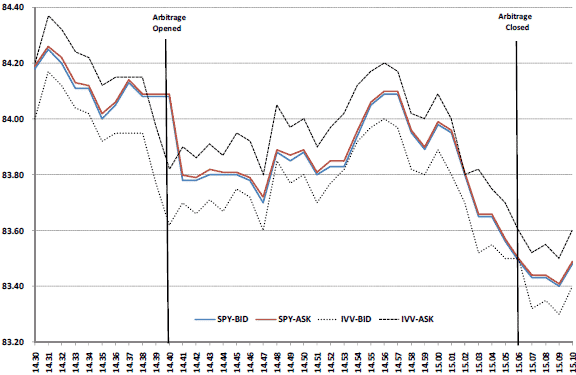Does pairs trading work for exchange-traded funds (ETF)? In the November 2010 version of their paper entitled “ETF Arbitrage”, Ben Marshall, Nhut Nguyen and Nuttawat Visaltanachoti examine arbitrage opportunities among three dollar-traded ETFs designed to track the S&P 500 Index: SPDR S&P 500 (SPY); iShares S&P 500 Index (IVV); and, the Swiss Exchange iShares S&P 500 (IUSA). The baseline strategy requires a minimum 0.2% ETF price divergence as a conservative threshold for long-short trade initiations to ensure that a large number of very small divergences, arguably subsumed by transaction fees, do not dominate results. This strategy terminates trades upon ETF price convergence. The authors conservatively assume a 15-second execution delay for opening and closing (fill or kill) orders. Using “cleaned” high-frequency, post-decimalization price data from normal trading hours minus the first and last 5 minutes for SPY and IVV (IUSA) from February 2001 (June 2004) through August 2010, they find that:
- Conservatively assuming a capital requirement equal to opening long positions, the baseline strategy applied to SPY-IVV (see the chart below for an example) generates an average 20 opportunities per year and an average annual profit, net of spreads but not broker fees, of 6.7% over the February 2001 through August 2010 sample period.
- Because of larger and more frequent price divergences, profits are considerably larger when applied to IUSA. For the baseline strategy over the period June 2004 through August 2010, there are an average of 45 (31) trades per year for SPY–IUSA (IVV–IUSA), with an average annual profit before broker fees of 28.9% (24.1%).
- Average profits per round-trip trade for the baseline strategy before broker fees are about 0.3% for SPY–IVV, 0.7% for SPY–IUSA and 0.8% for IVV–IUSA transactions.
- Given the very low broker fees for trading these assets over the sample period, estimated profits are arguably very close to those that large hedge funds/institutions could earn.
- Order imbalances increase quickly when ETF pair prices diverge, and divergences disappear quickly. The opportunity duration is typically five minutes. The median duration of a long IVV-short SPY pair trade is just 23 minutes.
- Shifting the threshold divergences for trade initiation and termination to higher levels tends to reduce profitability.
- Opportunities for exploiting SPY-IVV divergences are sparse the last two years, but there is no decline in opportunities involving IUSA.
- During the flash crash, these ETFs traded at discounts to the S&P 500 Index of more than 10%, with some large divergences from each other. However, because exchanges reversed many trades during this event, results exclude these opportunities.
- Larger arbitrage opportunities may exist for matched pairs of leveraged index ETFs.
The following chart, taken from the paper, illustrates a SPY-IVV pair trade from November 11, 2002. The trade opens at 14:40 by selling (buying) SPY (IVV) at the bid (ask) and closes at 15:06 by selling (buying) IVV (SPY) at the bid (ask). Profit before broker fees is 0.31%, assuming opening capital equal to the long position. Assigning proceeds from the short position to finance the long position would substantially boost profitability.

Reservations concerning these results are:
- Transaction costs for individual traders (small trades) may defeat profitability.
- The market may adapt to the findings.
In summary, evidence indicates that nimble, low-cost traders may be able to exploit price divergences between pairs of matched index ETFs.